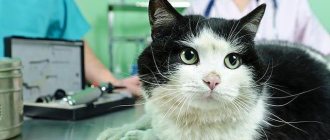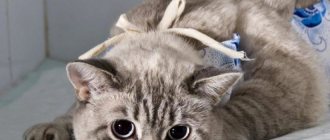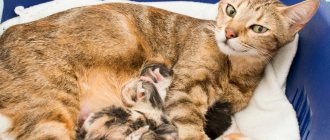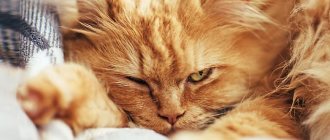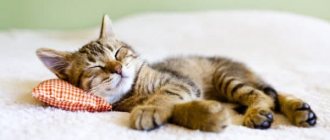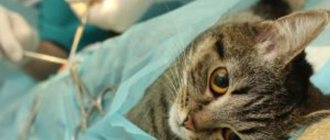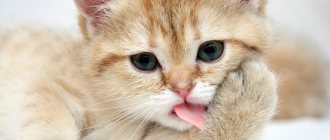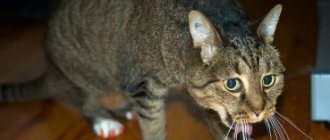7267Administration
The question of sterilizing a cat sooner or later arises before every owner. A cute pet from a quiet animal suddenly becomes very aggressive, and even the neighbors are bothered by constant loud purrs, and the point is not at all in changes in character, but in the fact that the nature of the animal is ready for procreation. But often it is not possible to find a worthy “spouse” or the owner simply does not want to give the kittens a home.
Then sterilization comes to the rescue - an operation that has been successfully performed by veterinarians around the world for many years, which can sometimes result in problems with the character and behavior of the animal - the cat sleeps a lot after sterilization or, on the contrary, is aggressive.
Consequences of anesthesia
The permissible sleep time after surgery depends on the method of administering anesthesia and the amount of drug administered. Therefore, when picking up a cat from the clinic after sterilization, it is worth asking the surgeon when she should wake up.
Important! Exceeding the specified period should be a reason to contact a specialist, even if all the vital functions of the animal are normal.
It is forbidden to independently remove a cat from anesthesia early using pharmacological drugs. But you can stimulate her to wake up in a timely manner by gently massaging her paw pads and ears. It is considered normal if, a short time after emerging from anesthesia, the female falls asleep again and sleeps until the next morning. During a short period of wakefulness, the animal may experience involuntary vomiting, urination or defecation.
Also observed:
- impaired coordination of movements;
- lethargy;
- inactivity;
- squatting on the hind limbs;
- lack of orientation in space.
On the first day, this condition should not cause alarm, as it is a direct consequence of the effects of narcotic drugs.
Causes of lethargy on the second day
It happens that already on the second day the cat begins to show activity. Her interest in toys awakens and her appetite is restored. But more often, pampered pets remain sedentary and lethargic. They often still have nausea, which results in a refusal to feed.
Important! During the second day, you need to make sure that the cat goes to the toilet. Lack of urination or defecation is a reason to immediately consult a doctor.
If the temperature indicators have not yet returned to normal and remain low, then you must continue to place a heating pad under the female’s back and rub the cold limbs. A toilet and a container of clean water should be placed nearby so that the cat does not have to travel long distances to satisfy its natural needs.
If the female does not get up at all, and an attempt to get up ends in a fall on her hind legs, then this indicates a complication after anesthesia. Most often this occurs when epidural anesthesia is administered incorrectly. In this case, you need to consult a specialist.
The cause of lethargy may be pain, the symptoms of which are:
- unnatural posture;
- plaintive meowing or loud screams;
- attempts to hide in a secluded place;
- manifestation of aggression in response to a person’s attempt to touch a sore spot.
In this case, you should consult your veterinarian about the use of pain medications.
Day five
Again this girl took off her blanket at night. Good girl, the cat needs to wash herself. This time it was easier to put it on Alice. When they dressed her on Wednesday, the cat’s body was somehow tense, but now it’s softer. Eh, I have to wait another week before the stitches are removed. I don’t see what’s going on with her.
Blanket inside
Today she no longer lies on the rug in the hallway, she moved into a house with toys. He sleeps there. But when I looked at her, it turns out that she had pulled the blanket off the wound and was licking her seam. Such a hooligan. I had to tie it tighter.
Aliska feels calmer with soft toys
And in the evening she fiercely licked the blanket at the seam. Apparently the wound is healing and itching.
Causes of lethargy on the third day
If the cat sleeps a lot on the third day after sterilization, then you should pay attention to the following factors:
- presence of elevated body temperature;
- redness of the suture area or the appearance of purulent discharge on it;
- pallor of the visible mucous membranes and the inner surface of the ears;
- constipation;
- vomit;
- tension and pain in the abdominal wall;
- convulsions or paralysis.
An alarming symptom is refusal of water and dry mucous membranes. To prevent dehydration, it is necessary to inject saline solution with glucose intravenously or subcutaneously. If the act of swallowing is not impaired, then you can give the female water using a pipette or syringe . If any of the listed signs are detected, you should call a doctor at home.
Features of feeding
At the end of the rehabilitation period, the animal becomes completely healthy, which means that its diet should be the same as before the operation. Very often, a sterilized cat begins to eat more than usual, as a result of which she quickly gains weight. The owner should pay attention to this and limit the intake of smoked, fatty, salty foods, as well as pasta, beans, fish and bread.
Obesity of a cat after sterilization
To prevent constipation, dry food offered to your pet should be pre-soaked. To prevent your cat from gaining excess weight, you need to play with it more than before.
Dangerous pathologies accompanied by lethargy
If the cat remains lethargic within 5 days after sterilization, this may indicate the development of serious pathologies.
Intra-abdominal bleeding
The presence of this complication is indicated by the following symptoms:
- bloody discharge from the vagina or postoperative suture;
- pain in the abdominal area;
- abdominal wall tension;
- pallor of mucous membranes.
Only timely surgical intervention can save a cat’s life.
In case of severe blood loss, the animal is prescribed hemo-restoring therapy.
Strangulated hernia
The discovery of a protrusion near the postoperative suture indicates the formation of a strangulated hernia. In this case, the female experiences a lack of appetite, constipation and vomiting. The lump itself is painful, hot to the touch, and has a reddish-bluish tint.
The absence of urination may indicate infringement of not only the intestinal loops, but also the bladder. The lack of surgical intervention inevitably leads to death.
Peritonitis
The development of a severe inflammatory process in the abdominal cavity may be a consequence of:
- falling of pathogenic microflora into the wound during surgery;
- necrotic damage to an area of the intestine due to a hernia;
- violation of the integrity of the bladder or intestines during surgical procedures or as a result of a strong blow and compression of the female’s abdomen;
- intra-abdominal bleeding.
The cat's temperature rises, there is a refusal to eat and severe abdominal pain. Treatment is surgery and antibiotic therapy. But you should know that the mortality rate with peritonitis is very high.
Thromboembolism
Neutering can cause a cat to form a blood clot in a large artery or vein, which can then travel and block smaller blood vessels.
Depending on the location of the thrombus, general lethargy is combined with the following clinical signs:
- violation of movement coordination;
- paralysis of the hind limbs, accompanied by stiffening of the muscles;
- blockage of the renal arteries is accompanied by symptoms of intoxication and severe pain in the abdominal area;
- a blood clot in the vessels of the brain manifests itself in epileptic seizures and coma;
- partial obstruction of the pulmonary arteries reveals itself with a severe cough, pallor of the mucous membranes and characteristic swelling of the jugular vein;
- vomiting and diarrhea mixed with blood indicate damage to the mesenteric arteries.
This serious disease can be treated surgically, but there is a high mortality rate. Fortunately, thromboembolism is a rare disease, but it is important for the owner to be aware of the possibility of its occurrence in order to pay attention to alarming symptoms in time.
Signs of postoperative pathology
In this case, the animal may observe the following:
- The weakness after surgery is very pronounced; the cat cannot get up or does not try to do so at all, even when two days or more have passed since the operation. It’s not at all good when a pet meows pitifully and hoarsely, and then suddenly falls, as if cut down. This may indicate very serious postoperative pathologies.
- The cat's breathing is unstable, shallow, intermittent and hoarse. In some cases, this clinical picture indicates the development of aspiration pneumonia or other pathologies of the respiratory system.
- The pet is not only weak and lethargic, but also completely refuses to eat after two or three days from the moment of sterilization. It's much worse when she doesn't drink. In such cases, you should contact your veterinarian immediately.
So, there are only two main reasons for postoperative lethargy:
- Consequences of the administration of drugs used for anesthesia.
- Development of postoperative complications.
Important! Complications usually develop in the first three days after sterilization, and therefore you need to know well what is normal and what indicates pathology.
What to do if your cat is lethargic after sterilization
Not knowing what to do if a cat remains lethargic for a long time after sterilization, some owners resort to “proven” traditional methods of treatment, pouring alcohol-containing drinks into the animal, doing enemas, trying to repair the hernia themselves, or simply giving painkillers.
Often this ends with a call to the doctor with a request to “resuscitate the pet” when the female is already in a state of death throes. It is very important to contact the clinic promptly if you notice any deviations in the behavior or condition of the animal.
Note! You should not give your cat analgesics before examining a doctor, as this will hide the pain syndrome and make it difficult to make a diagnosis.
Compliance with all the rules of preoperative preparation, choosing a reliable clinic and competent care during the rehabilitation period will minimize the possibility of complications, speed up the wound healing process and ensure a quick recovery of the animal after sterilization.
Why does a cat scream or even yell?
In the postoperative period, cats begin to scream in the event of an incomplete operation, if the ovaries of an adult cat were bandaged. Thus, the pet screams again, shows its character, begins to ask and want a cat. If a cat screams or yells after sterilization, it is better to completely operate on the animal and reduce its sexual desire to nothing.
In rare cases, when an animal yells or screams aggressively, this indicates severe pain. She may also scream due to nausea. Or the pet screams or yells to attract the owner's attention. If your dog screams a lot for a long time, you should definitely take her to the veterinary clinic to make sure that everything is fine with her.
